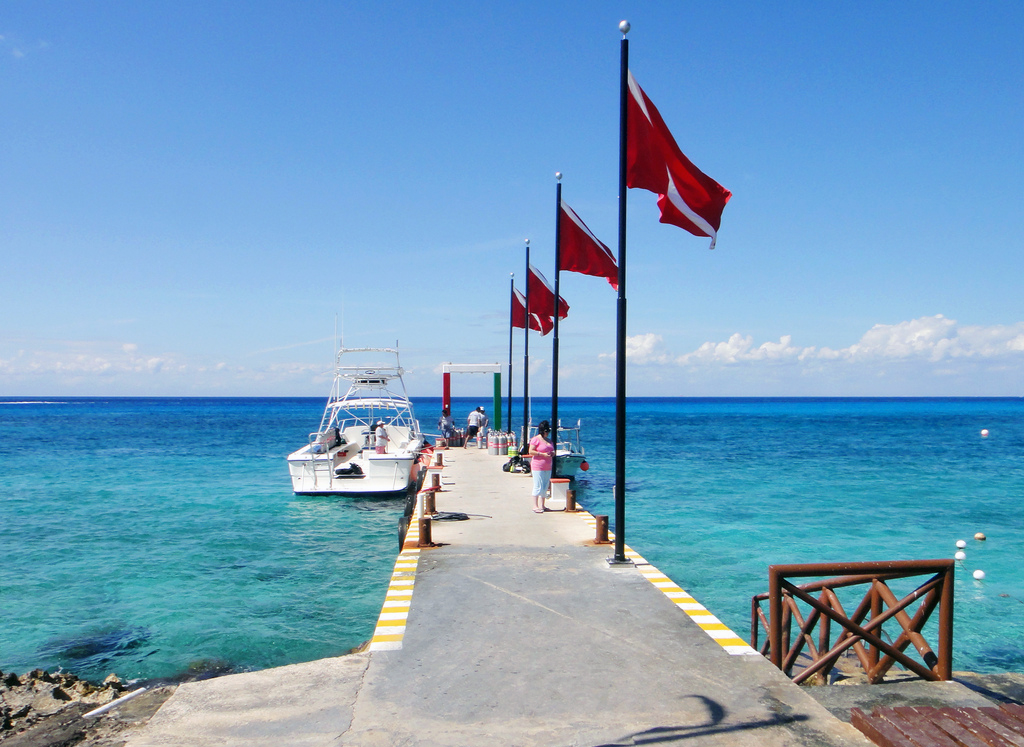There are more than 100 dive shops on Isla Cozumel, and scores more at Isla Mujeres, Playa del Carmen, Cancún, Tulum, and elsewhere. Choosing just one—and then placing all your underwater faith into its hands—can be daunting.

The dock at Fiesta Americana’s Dive Resort Cozumel. Photo © Serge Melki, licensed Creative Commons Attribution.
If the staff is reluctant to show you the gear, either they aren’t too proud of it or they don’t see clients as equal partners in dive safety—both red flags.Safety should be your number-one concern in choosing a shop. Fortunately, the standards in Cozumel and the Riviera Maya are almost universally first-rate, and accidents are rare. But that’s not a reason to be complacent. For example, don’t dive with a shop that doesn’t ask to see your certification card or logbook—if they didn’t ask you, they probably didn’t ask anyone else, and ill-trained divers are as dangerous to others in the group as they are to themselves.
Also ask how long the shop has been in business, how much experience the dive guides have, how long the captain and crew have been with the shop, and how many divers per guide will be on the tour. “Cattle boats” are a sign of shops trying to maximize profits; even if they’re not unsafe, they often make for a less enjoyable experience.
Equipment is another crucial issue. You should ask to inspect the shop’s equipment, and the dive shop should be quick to comply. Although few casual divers are trained to evaluate gear, a good dive shop will appreciate your concern and be happy to put you at ease. If the staff is reluctant to show you the gear, either they aren’t too proud of it or they don’t see clients as equal partners in dive safety—both red flags.
Of course, the most important equipment is not what’s on the rack but what you actually use. On the day of your dive, get to the shop early so you have time to double-check your gear. Old equipment is not necessarily bad equipment, but you should ask for a different BCD, wetsuit, or regulator if the condition of the one assigned to you makes you uneasy. Learn how to check the O-ring (the small rubber ring that forms the seal between the tank and the regulator), and do so before every dive. You also should attach your regulator and open the valve, to listen for any hissing between the regulator and the tank, or in the primary and backup mouthpieces. If you hear any, ask the dive master to check it and, if need be, change the regulator. Arriving early lets you do all this before getting on the boat—ideally before leaving the shop—so you can swap gear if necessary.
Feeling comfortable and free to ask questions or raise concerns (of any sort at any time) is a crucial factor in safe diving. That’s where a dive shop’s personality comes in. Every dive shop has its own culture or style, and different divers will feel more comfortable in different shops. Spend some time talking to people at a couple of different dive shops before signing up. Try to meet the person who will be leading your particular dive—you may have to come in the afternoon when that day’s trip returns. Chances are one of the shops or dive masters will click with you.
Finally, there are some specific questions you should ask about a shop’s practices. Has their air been tested and certified? Do they carry radios and oxygen? Does the captain always stay with the boat? How many people will be going on your dive? How advanced are they? And how many dive masters or instructors will there be? How experienced are they? Above all, be vocal and proactive about your safety, and remember there are no stupid questions.
And, of course, have fun!
Excerpted from the Twelfth Edition of Moon Cancun & Cozumel.